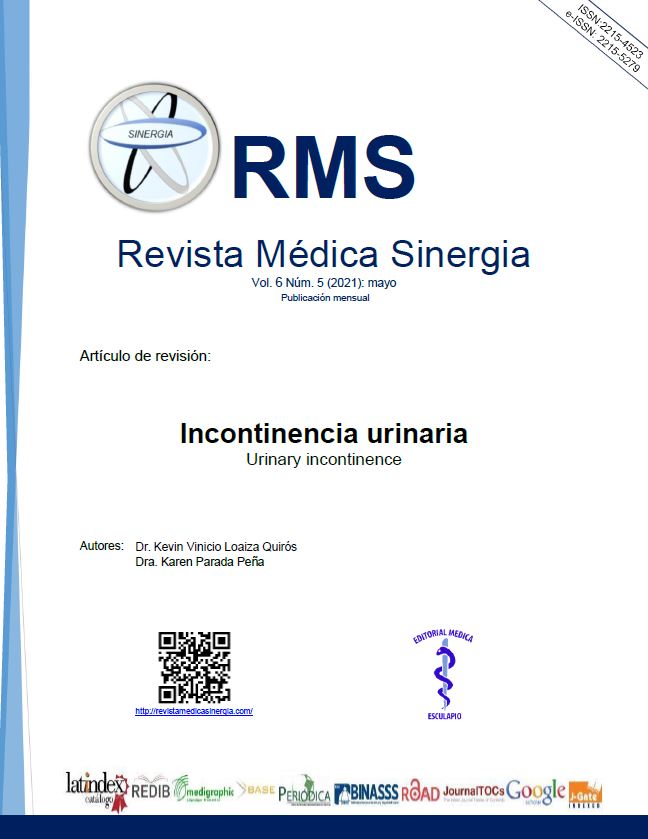Resumen
La incontinencia urinaria es un padecimiento con una gran prevalencia, especialmente en la población femenina cuyo riesgo aumenta con la edad, sin embargo también se asocia al periodo perinatal, obesidad y deterioro cognitivo. Debido a la carga social y psicológica que conlleva para las pacientes, muchas veces no es documentada y no reciben tratamiento, por lo que se cree que la prevalencia es mayor a la estimada. El tratamiento debe personalizarse, dependiendo del tipo de incontinencia y gravedad de los síntomas.
Palabras clave
Citas
Bardsley A. An overview of urinary incontinence. British Journal of Nursing. 2016;25(18):S14-S21. https://doi.org/10.12968/bjon.2016.25.18.S14
Kopańska M, Torices S, Czech J, Koziara W, Toborek M, et al. Urinary incontinence in women: biofeedback as an innovative treatment method. Therapeutic Advances in Urology. 2020;12.https://doi.org/10.1177/1756287220934359
Lukacz ES, Santiago-Lastra Y, Albo ME, Brubaker L. Urinary Incontinence in Women: A Review. JAMA. 2017;318(16):1592-1604. https://doi.org/10.1001/jama.2017.12137
Muth CC. Urinary Incontinence in Women. JAMA. 2017;318(16):1622. https://doi.org/10.1001/jama.2017.15571
Milsom I, Gyhagen M. The prevalence of urinary incontinence. Climacteric. 2019;22(3):217-222. https://doi.org/10.1080/13697137.2018.1543263
Gibson W, Wagg A. Incontinence in the elderly, 'normal' ageing, or unaddressed pathology? Nature Reviews Urology. 2017 Jul;14(7):440-448. https://doi.org/10.1038/nrurol.2017.53
Díaz F, Fuentes M, Rivadeneira A, Acuña L. Prevalencia de incontinencia urinaria en el posparto. Revista Cubana de Obstetricia y Ginecología. 2017;43(2):1-11. Disponible en: http://www.revginecobstetricia.sld.cu/index.php/gin/article/view/209
Elmelund M, Klarskov N, Biering-Sørensen F. Prevalence of urinary incontinence in women with spinal cord injury. Spinal Cord. 2018 Dec;56(12):1124-1133. https://doi.org/10.1038/s41393-018-0157-0
Aoki Y, Brown H, Brubaker L, Cornu JN, Daly JO, et al. Urinary incontinence in women. Nature Reviews Disease Primers. 2017;3(17042). https://doi.org/10.1038/nrdp.2017.42
Wyndaele M, Hashim H. Pathophysiology of urinary incontinence. Surgery (Oxford). 2017;35(6):287-292, https://doi.org/10.1016/j.mpsur.2017.03.002
Palaiologos K, Annappa M, Grigoriadis G. Correlation Between Urodynamic and Clinical Diagnoses in Classifying the Type of Urinary Incontinence in Women. Cureus. 2019;11(10):e6016. https://doi.org/10.7759/cureus.6016
Silva MA, Gallardo M, López C, Santander C, Torres J. Efectos de la incontinencia urinaria en la calidad de vida de la mujer climatérica. Revista Cubana de Obstetricia y Ginecología. 2018;44(1): 1-14. Disponible en: http://revginecobstetricia.sld.cu/index.php/gin/article/view/307
Irwin GM. Urinary Incontinence. Primary Care: Clinics in Office Practice. 2019;46(2):233-242. https://doi.org/10.1016/j.pop.2019.02.004
Murukesu RR, Singh DKA, Shahar S. Urinary incontinence among urban and rural community dwelling older women: prevalence, risk factors and quality of life. BMC Public Health. 2019;19(Suppl 4):529. https://doi.org/10.1186/s12889-019-6870-6
Aharony L, De Cock J, Nuotio MS, Pedone C, Rifel J, et al. Consensus document on the detection and diagnosis of urinary incontinence in older people. European Geriatric Medicine. 2017;8(3):202-209. https://doi.org/10.1016/j.eurger.2017.03.012
Goforth J, Langaker M. Urinary Incontinence in Women. North Carolina Medical Journal. 2016;77(6):423-425. https://doi.org/10.18043/ncm.77.6.423
Dufour S, Wu M. No. 397 - Conservative Care of Urinary Incontinence in Women. Journal of Obstetrics and Gynaecology Canada. 2020;42(4):510-522. https://doi.org/10.1016/j.jogc.2019.04.009
Diokno AC, Newman DK, Low LK, Griebling TL, Maddens ME, et al. Effect of Group-Administered Behavioral Treatment on Urinary Incontinence in Older Women: A Randomized Clinical Trial. JAMA Internal Medicine. 2018;178(10):1333-1341.
https://doi.org/10.1001/jamainternmed.2018.3766
Kilpatrick KA, Paton P, Subbarayan S, Stewart C, Abraha I, et al. Non-pharmacological, non-surgical interventions for urinary incontinence in older persons: A systematic review of systematic reviews. The SENATOR project ONTOP series. Maturitas. 2020;133:42-48. https://doi.org/10.1016/j.maturitas.2019.12.010
Dumoulin C, Cacciari LP, Hay‐Smith EJC. Pelvic floor muscle training versus no treatment, or inactive control treatments, for urinary incontinence in women. Cochrane Database of Systematic Reviews 2018;(10). Art. No.: CD005654. https://doi.org/10.1002/14651858.CD005654.pub4
Woodley SJ, Boyle R, Cody JD, Mørkved S, Hay‐Smith EJC. Pelvic floor muscle training for prevention and treatment of urinary and faecal incontinence in antenatal and postnatal women. Cochrane Database of Systematic Reviews. 2017;(12). Art. No.: CD007471. https://doi.org/10.1002/14651858.CD007471.pub3
Wilson M. Urinary incontinence: considering the physical and psychological implications. British Journal of Community Nursing. 2016;21(5):222-4. https://doi.org/10.12968/bjcn.2016.21.5.222
Favre-Inhofer A, Dewaele P, Millet P, Deffieux X. Systematic review of guidelines for urinary incontinence in women. Journal of Gynecology Obstetrics and Human Reproduction. 2020:101842. https://doi.org/10.1016/j.jogoh.2020.101842
Yang B, Foley S. Overview on the management of adult urinary incontinence. Surgery (Oxford). 2020;38(4):204-211, https://doi.org/10.1016/j.mpsur.2020.01.016
Chughtai B, Thomas D, Sun T, Sedrakyan A. Failures of Sacral Neuromodulation for Incontinence. JAMA Surgery. 2018;153(5):493-494 https://doi.org/10.1001/jamasurg.2017.6093
Sung VW, Borello-France D, Newman DK, Richter HE, Lukacz ES, et al. Effect of Behavioral and Pelvic Floor Muscle Therapy Combined With Surgery vs Surgery Alone on Incontinence Symptoms Among Women With Mixed Urinary Incontinence: The ESTEEM Randomized Clinical Trial. JAMA. 2019;322(11):1066-1076. https://doi.org/10.1001/jama.2019.12467
Jelovsek JE. Predicting urinary incontinence after surgery for pelvic organ prolapse. Current Opinion Obstetrics Gynecology. 2016 Oct;28(5):399-406 https://doi.org/10.1097/GCO.0000000000000308
Mota RL. Female urinary incontinence and sexuality. Int Braz J Urol. 2017;43(1):20-28. https://doi.org/10.1590/s1677-5538.ibju.2016.0102
Pinheiro LR, Fernandez D, Ribeiro IP, Lira do Nascimento S, Morais AV, et al. The Impact of Urinary Incontinence on Sexual Function: A Systematic Review. Sexual Medicine Reviews. 2020;8(3):393-402. https://doi.org/10.1016/j.sxmr.2019.06.009
Moon S, Chung HS, Yu JM, Na HR, Kim SJ, et al. "Impact of Urinary Incontinence On Falls in the Older Population: 2017 National Survey of Older Koreans." Archives of Gerontology and Geriatrics. 2020;90:104158. https://doi.org/10.1016/j.archger.2020.104158

Esta obra está bajo una licencia internacional Creative Commons Atribución-NoComercial 4.0.
Derechos de autor 2021 Array


